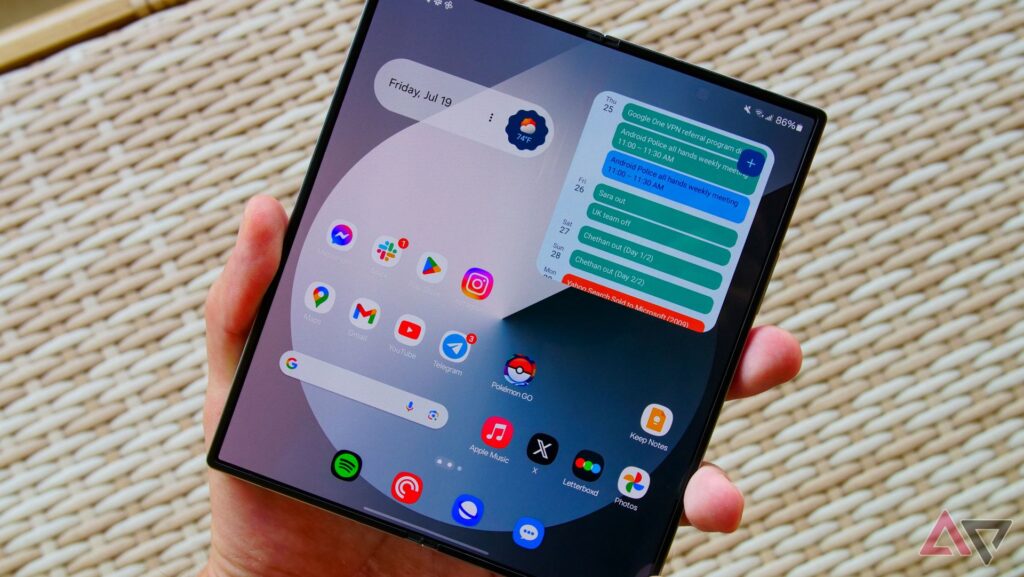
Samsung’s recent teaser for the Galaxy Fold Ultra has sparked a wave of reactions, with the company hinting at a new foldable device featuring a larger display and enhanced camera system. While these upgrades might seem like logical steps, they may not address the core issues hindering the widespread adoption of foldable phones.
The announcement comes as Samsung continues to face criticism from enthusiasts who feel that the current Galaxy Z Fold models do not justify their premium price tags. These users often point to the “inferior” camera specs and smaller displays compared to some international competitors. However, these are not the primary reasons why Samsung’s book-style foldables have struggled to capture a larger market share.
Samsung’s Focus: Bigger Screens and Better Cameras
Samsung’s decision to prioritize a larger display and improved cameras for the Galaxy Fold Ultra has left some users, including myself, disappointed. Although the expansive internal displays of some overseas foldables are impressive, they do not necessarily enhance the user experience. Personally, I find the extra space on my Galaxy Z Fold 6 underutilized and often frustrating.
The external display experience of the Galaxy Z Fold 6 falls short when compared to traditional devices like the Galaxy S25 Ultra. The internal display’s aspect ratio results in black bars during video playback, making the viewing area only marginally larger than a standard smartphone. Despite improvements in durability over recent generations, potential buyers should still exercise caution with foldables in certain environments, such as the beach.
“Durability has improved over the last few generations, but you should still think twice before bringing one to the beach.”
The Price and Practicality Dilemma
Meanwhile, clamshell foldables, which are more practical and affordable, have a better chance of gaining wider adoption. Devices like the Motorola Razr 2025 allow users to maintain their typical smartphone habits without significant adjustments. In contrast, book-style foldables require a change in mindset, which, coupled with high prices, can deter potential buyers.
Even if Samsung manages to keep the Galaxy Fold Ultra’s price around $2,000, it remains a hefty investment. The market needs more affordable foldables to encourage broader adoption. However, price is not the only barrier; the lack of compelling reasons to switch from traditional smartphones is another significant factor.
Software: The Missing Piece
For foldable phones to justify their premium, Samsung needs to focus on software enhancements. While hardware improvements like larger displays and better cameras are appealing, they do not address the practical challenges of using a foldable device. A dedicated version of One UI for foldables, leveraging the potential of Android 12L, could significantly enhance the user experience.
Moreover, more apps need to utilize the additional screen real estate effectively. A tailored experience for power users, with features like improved photo and video editing interfaces and enhanced multitasking, could make foldables more attractive. Samsung’s commitment to software innovation could pave the way for future hardware improvements.
“If Samsung commits to changing its software mindset for large folding phones, then we can discuss improving specs and cameras.”
Looking Ahead: The Future of Foldables
Despite my love for technology and foldable phones, clamshell devices like the Motorola Razr remain my preferred choice. Samsung’s rumored trifolding phone might have better prospects, offering a 16:9 aspect ratio that provides more options for app developers and showcases the capabilities of the Snapdragon 8 Elite processor.
Until then, consumers will have to contend with devices like the Galaxy Fold Ultra. While it may offer improved photography capabilities, the broader question remains: will these enhancements be enough to sway users from traditional smartphones?
The foldable market is at a crossroads, and Samsung’s next moves could determine its future trajectory. For now, the focus should be on creating a compelling reason for consumers to embrace foldables, beyond just hardware upgrades.







